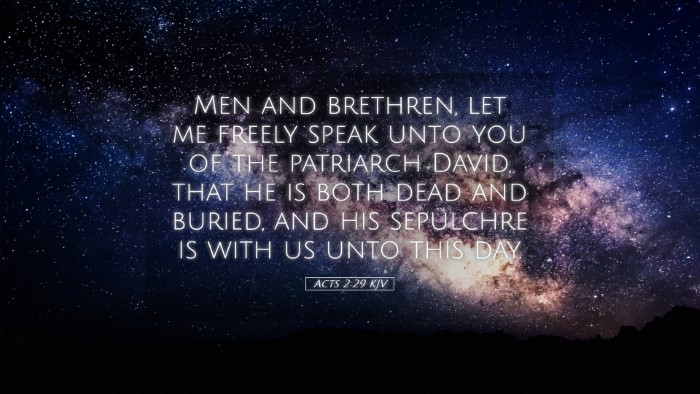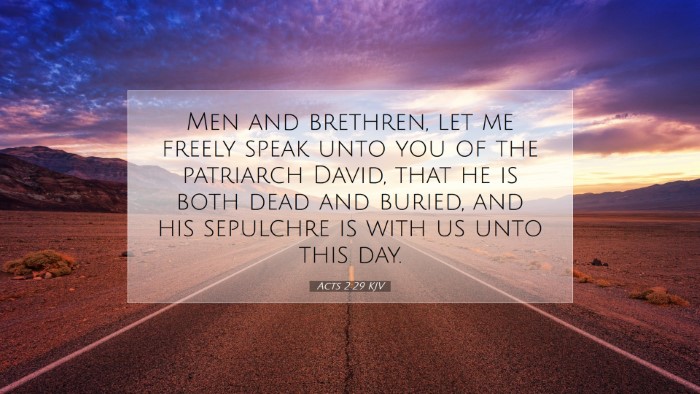Commentary on Acts 2:29
Bible Verse: "Men and brethren, let me speak freely to you of the patriarch David, that he is both dead and buried, and his tomb is with us to this day." (Acts 2:29)
Introduction
This verse is part of Peter's sermon on the Day of Pentecost, where he addresses the crowd and begins to expound on the significance of David in relation to the resurrection of Jesus Christ. The verse provides an essential part of Peter's argument that frames Jesus as the fulfillment of Old Testament prophecy.
Contextual Analysis
In the context of Acts 2, Peter stands up to explain the events of Pentecost following the outpouring of the Holy Spirit. His audience, comprising Jews from various nations, holds a reverence for David and the promises associated with him. Peter uses this respect to connect the messianic expectations surrounding David with Jesus, who fulfills those prophecies.
Insights from the Commentaries
Matthew Henry's Commentary
Matthew Henry emphasizes that Peter speaks "freely," which is indicative of the boldness imparted by the Holy Spirit. He notes that David’s death and burial are factual reminders that though he was a great king and prophet, he could not overcome death. Furthermore, Henry asserts that the reference to David serves to highlight the difference between the corruptible lineage of David and the incorruptible nature of Christ’s resurrection. David’s tomb was a visible evidence of his mortality, thus leading to the profound impact of Christ's resurrection as the promised everlasting king.
Albert Barnes' Notes on the Bible
Albert Barnes takes a historical approach to this verse. He outlines how the mention of David's tomb serves as a tangible point of reference for those present. His argument furthers the notion that while David had a significant role in the lineage of Christ, he was not the final answer to the messianic prophecy. Barnes highlights that Peter's intent is to establish a contrast between the death of an esteemed patriarch and the life of Jesus. By affirming that David is "both dead and buried," Peter sets the stage for establishing Jesus as the resurrected Lord who transcends death itself.
Adam Clarke's Commentary
Adam Clarke offers a theological lens focusing on the implications of this verse in the wider narrative of salvation history. He discusses how Peter’s mention of David is intended to bring clarity to the audience: that although David was a revered figure, he had not ascended to heaven, thus verifying that the fulfillments of prophecies regarding the Messiah must be applied to Christ alone. Clarke points out that Peter’s assertion about David’s tomb serves to remind the people of their own mortality and the necessity of looking to Jesus as the one who conquers death.
Theological Implications
The verse lays the groundwork for understanding the significance of resurrection in Christian theology. By referencing David—a foundational figure in Jewish history—Peter draws a clear line between the promises made in the Old Testament and their realization in the New. This connection not only affirms Jesus’ identity as the Messiah but also offers hope for believers regarding their own future resurrection. The essence of Peter's message is grounded in the certainty of the promise of life after death through Christ, contrasting with the temporal nature of earthly governors, including David.
Application for Pastors and Theologians
- Encouragement of Bold Proclamation: Peter’s example encourages pastors to speak boldly about Christ’s resurrection and its implications for humanity.
- Historical Context Understanding: A thorough understanding of historical context elevates the preaching of Scripture and affirms the relevance of biblical narratives in contemporary discussions.
- Messianic Fulfillment: The promise of the Messiah through David leads to reflection on how believers today are called to acknowledge Jesus as the ultimate fulfillment of all God’s promises.
- Hope in Resurrection: The assurance of life after death is a foundational truth that should be emphasized in pastoral care, offering hope and comfort to grieving families.
Conclusion
Acts 2:29 serves as a pivotal moment in the early sermon of Peter, calling attention to David’s mortality while highlighting Christ’s resurrection as the cornerstone of Christian faith. By understanding the depth of this verse through the insights of eminent commentaries, pastors, students, and scholars can further develop their theological foundations, leading to more profound ministry and teaching efforts.


